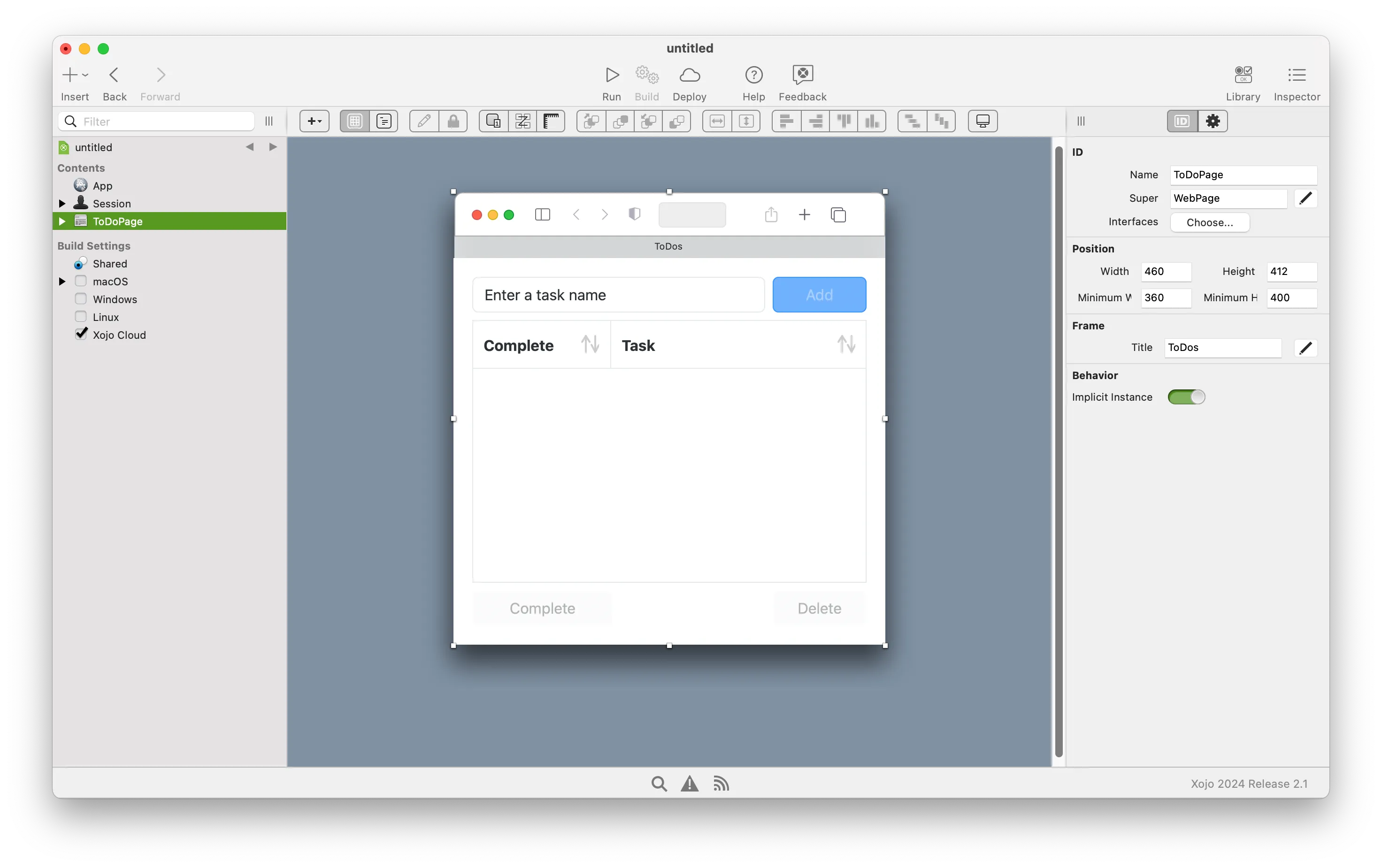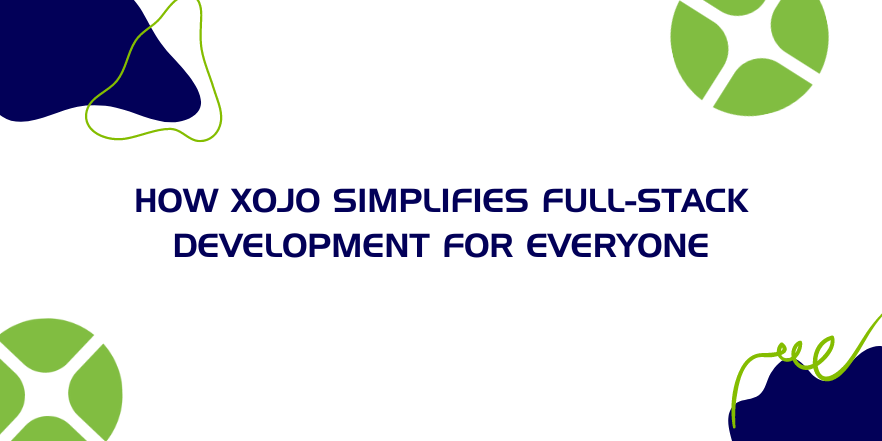The demand for skilled full-stack developers continues to grow in 2024. These developers handle both the frontend and backend of applications, ensuring a smooth user experience from start to finish. As businesses strive to deliver robust, efficient and visually appealing applications, developers and their choice of programming tools can impact the speed, scalability and overall performance of a full software solution.
Presented with choosing what development tool is best for your main, full-stack development needs, let’s discuss the benefits of Xojo development platform for your next web project. With its simplicity, flexibility, and powerful features, Xojo will help you create high-quality web applications quickly and efficiently, with the added bonus of covering backend and frontend development in the same IDE—no more language switching—while also lowering your overall costs.
Overview of Full-Stack Development
Full-stack development covers the entire spectrum of technologies and skills required to create a fully functional web application. This approach involves both the frontend, which users interact with directly, and the backend, which powers the application.
At its core, full-stack development refers to the ability to work on both the client-side and server-side of an application. This means that full-stack developers should be proficient in frontend technologies such as HTML, CSS, JavaScript, as well as backend technologies like Node.js, Python, and frameworks such as React and Django. Full-stack developers possess a broad skill set that includes designing user interfaces, managing databases, and server logic, enabling them to oversee the entire development process.
Usually, a full-stack developer handles:
- Frontend Technologies: These consist of HTML for structure, CSS for styling, and JavaScript for interactivity, crucial for crafting engaging user interfaces. Frameworks such as React, Angular, and Vue.js are also typical choices for building dynamic web applications.
- Backend Technologies: This segment covers server-side programming languages like Node.js, Python, Ruby, and PHP, coupled with frameworks such as Express, Django, and Ruby on Rails, essential for robust backend development. Databases, both relational (e.g., MySQL, PostgreSQL) and NoSQL (e.g., MongoDB), are also crucial for data management.
- APIs (Application Programming Interfaces): APIs enable simple communication between frontend clients and backend applications/servers, facilitating the exchange of data. RESTful APIs and GraphQL are common approaches used in modern web applications.
Advantages in adopting a full-stack approach in software development:
- Faster Development Cycles: With a single developer or a small team capable of handling both frontend and backend tasks, projects can progress more quickly, reducing the time to market.
- Easy Integration: Full-stack developers have a comprehensive understanding of how the different components of an application interact, leading to better integration and fewer compatibility issues.
- Enhanced Problem-Solving: By possessing a complete view of the application, full-stack developers can identify and resolve issues more efficiently, improving overall project quality.
Why choose Xojo as a full-stack development solution?
When it comes to full-stack development, selecting the right programming language(s) or frameworks can significantly impact the efficiency and effectiveness of your projects. Xojo is a powerful choice for anyone seeking a robust, user-friendly and versatile development environment that provides everything needed to transform their ideas into fully fledged, working software products, no matter the platform or environment.
Xojo features ideal for full-stack development:
- Built-in Web Server: Xojo has its own built-in web server that allows developers to easily test and deploy web applications (on Linux or Windows servers) without the need for additional software. There is no need to set up complicated web server technologies or deal with compatibility issues and security. Xojo handles all of that for you. In production, you can run a web app built with Xojo as stand-alone or behind Apache or Nginx. You decide what works best for your project.
- Visual Development Environment: Xojo offers a visual development environment that allows developers to design user interfaces using drag-and-drop elements. This approach simplifies the process of creating appealing applications, accessible to both novice and experienced developers.
- Object-Oriented Programming: Xojo is object-oriented programming (OOP), enabling developers to create modular and reusable code. OOP encourages better organization and maintainability of applications, making it easier to scale projects over time.
- Compiled Code: Xojo compiles code into machine code, which results in fast and efficient web applications. In the event that some bad actors gain access to your server, rest assured that Xojo built web apps are more secure than those built with other tools.
In addition to these features, while many programming languages cater to full-stack development by combining and utilizing multiple external solutions, Xojo distinguishes itself as an ideal, singular solution. Compared to languages like JavaScript, Ruby, PHP or Python, Xojo has a gentle learning curve, making it an attractive option for beginners. Its syntax is straightforward and resembles natural language, which helps new developers learn concepts quickly. Xojo’s visual tools and drag-and-drop features enable developers to prototype applications rapidly. This is particularly advantageous for startups and businesses looking to iterate and launch products quickly.
Xojo for Frontend Development
Creating an engaging and user-friendly frontend is crucial for any web application. With Xojo, developers can quickly prototype and design visually appealing interfaces without the need for 3rd party tools or additional frameworks.
Xojo’s visual development environment makes building user interfaces an easy and enjoyable thing. With its drag-and-drop interface, developers can easily design and layout their GUI components- buttons, labels, and text fields- without needing any code at all. This intuitive approach allows developers to focus on the logic of the application rather than getting bogged down by low-level details.
So, what makes Xojo’s frontend capabilities so effective? For starters, it allows frontend developers to quickly:
- Prototype and test ideas without writing code;
- Easily create complex layouts and designs;
- Focus on the logic of the application rather than the UI;
- Collaborate more effectively with designers and other team members.
Example: A simple web app frontend built with Xojo
To illustrate the power of Xojo’s visual development environment, let’s take a look at a simple web app frontend built using Xojo. In this example, we’ll create a basic to-do list application with a user-friendly interface without writing any HTML, CSS or JavaScript code.

Coding Backend Functionality and Connecting it to the Frontend
While users interact with the frontend of apps, it’s the backend that does the heavy lifting, handling data and core functionality. Xojo makes building these backend systems easier for developers with useful features that create efficient server-side applications without unnecessary complexity. Xojo is a practical choice for developers who want to build solid, functional backends for web (and even desktop or mobile) apps without getting bogged down in overly complicated processes. Here are some notable aspects:
- Database Integration: Xojo supports out-of-the box connections to a variety of databases, including MySQL/MariaDB, PostgreSQL, SQLite, and ODBC. Besides the built-in database classes, now there’s also the DBKit project and the new DatabaseConnection project item.
- RESTful API Creation: Xojo makes it easy to create RESTful APIs, which are essential for enabling communication between the frontend and backend of a web application. By defining endpoints and handling HTTP requests and responses, developers can facilitate data exchange and enhance the interactivity of their varied applications and clients (web, desktop or mobile).
- Session Management: Managing user sessions is crucial for web applications, especially those that require user authentication. Xojo provides built-in support for easy session handling, allowing developers to track user activity and maintain state across different pages, improving the overall user experience.
Integrating the Frontend and Backend
Full-stack development works best when the frontend and backend of an app work well together. Xojo makes this easier by offering a single app development software solution for both parts. Developers can use the same programming language throughout the whole project, which saves time and reduces complications. This approach helps programmers focus on creating a smooth user experience without switching between different tools or languages.
Here are some key points worth taking into account when you want to start building your next successful application:
- Unified Language for Development: One of the standout features of Xojo is that it allows developers to work in one programming language, eliminating the need to switch between multiple languages like HTML, CSS, or JavaScript. This means that both the frontend and backend logic can be implemented using Xojo’s straightforward syntax, streamlining the development process, no matter the OS platform they’re building for.
- Single Integrated Development Environment (IDE): Xojo’s IDE serves as a centralized hub for managing both frontend design and backend coding. Developers can design user interfaces visually, drag and drop elements, and simultaneously write the corresponding backend code without needing to leave the IDE. This integration enables a more intuitive workflow, reducing the chances of errors and inconsistencies.
As the demand for agile and efficient software development continues to rise, the choice of programming language solutions and frameworks can have a significant impact on both project timelines and budgets. Xojo stands out as a compelling alternative for developers and teams accustomed to traditional stacks like LAMP (Linux, Apache, MySQL, and PHP) or MEAN (MongoDB, Express.js, Angular, and Node.js) or any other.
For organizations and startups already familiar with other development stacks, transitioning to Xojo can lead to significant savings in training costs. Xojo’s intuitive interface and single programming language approach mean that team members can quickly adapt without needing extensive retraining. This is especially beneficial for companies looking to onboard new developers or expand their teams. And as an extra plus, using Xojo, you can expand your application supported platforms to include building native desktop clients (Mac, Windows, Linux) or mobile clients (iOS, Android) , all with just one codebase.
And let’s not forget that managing a full-stack application typically involves maintaining multiple technologies, which can result in higher operational costs. Xojo minimizes the need for additional languages and frameworks, resulting in lower maintenance overhead costs and increased efficiency in full-stack development. Updates, debugging, and scaling become more straightforward, allowing teams to allocate resources more effectively.
Is it fair to call Xojo not just a great full-stack development suite but a full-stack development suite that truly optimizes the entire development process and maximizes productivity?
Gabriel is a digital marketing enthusiast who loves coding with Xojo to create cool software tools for any platform. He is always eager to learn and share new ideas!

